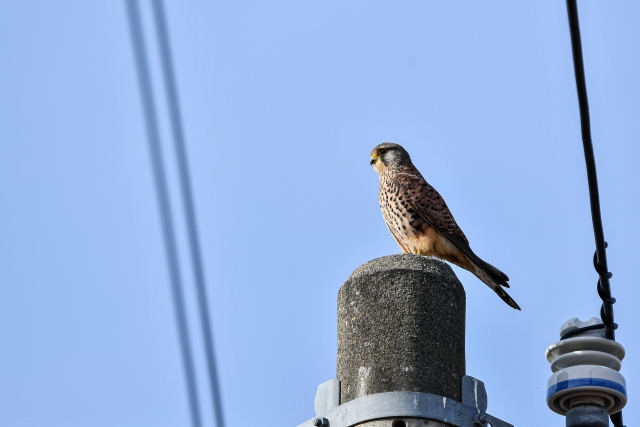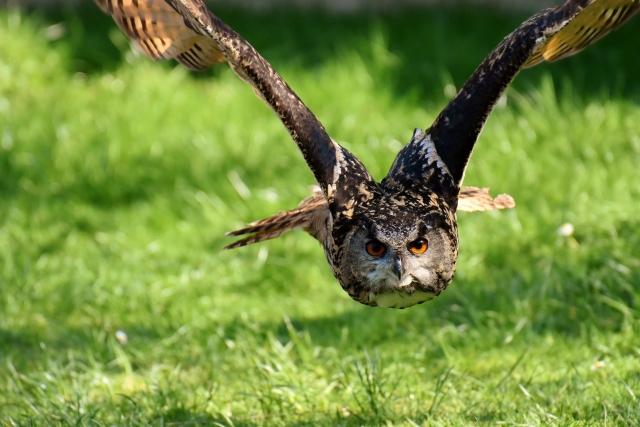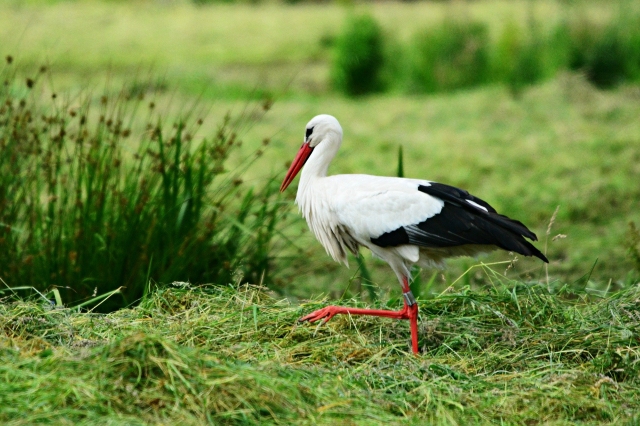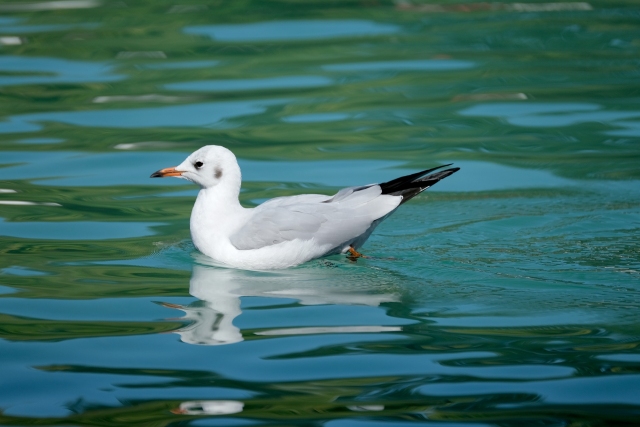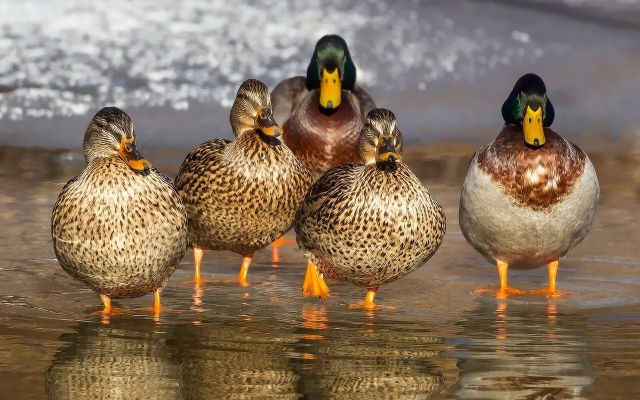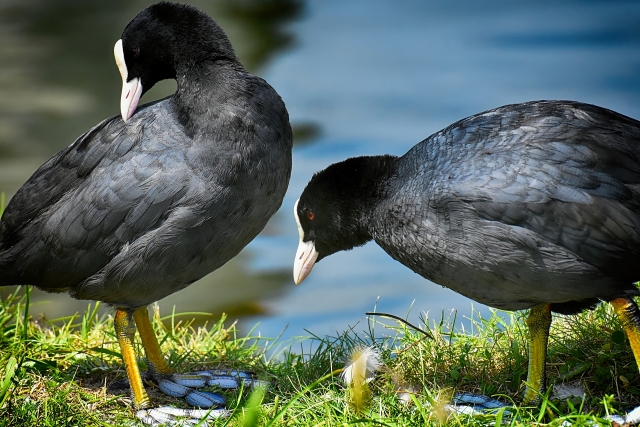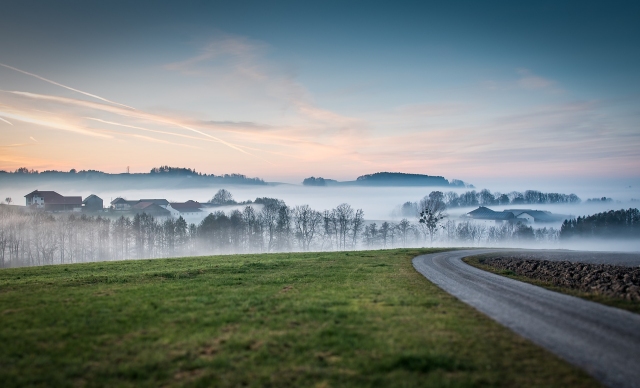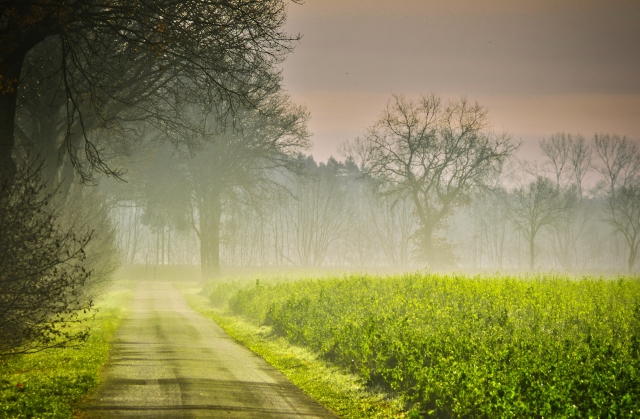Florian Heigl
European kestrel
Description
Kestrels show a pronounced sexual dimorphism in their plumage. The most striking distinguishing feature between male and female kestrels is the head colouration. Males have a gray head, while females are uniformly reddish brown in colour. Males also have small black and sometimes diamond-shaped spots on their reddish-brown backs. Their uppertail coverts, as well as the rear back and tail feathers are also light gray. The tail feathers has a distinct black terminal band with a white fringe. The underpart is pale cream and only very lightly mottled or streaked with brown. The underbelly and underwing coverts are nearly white.
The adult female is darkly cross-banded on the back. Unlike the male, the tail feathers are brown and also show several transverse stripes and a distinct terminal band. The underpart is also darker than on the male and shows heavier spotting. Juvenile birds are similar to females in their plumage. However, their wings appear rounder and shorter than adult kestrels. In addition, the tips of the primaries have lighter fringes. Ceroma and eye ring, which are yellow in adult birds, are light blue to greenish yellow in juveniles.
In both sexes, the tail is rounded as the outer tail feathers are shorter than the middle tail feathers. In adult birds, the wing tips reach the end of the tail. The legs are rich yellow, the talons black.
Habitat
typical habitats of the European kestrel
The kestrel is an adaptable species that can be found in a variety of habitats. In general, kestrels avoid both dense closed forests and completely treeless steppes. In Central Europe, it is a common bird of the cultivated landscape, which can live wherever there are shrubs or forest edges. Basically, it needs open areas with low vegetation for hunting. Where trees are absent, it uses the poles of power lines as nesting sites.
In addition to the presence of nesting opportunities, it is primarily the availability of prey that influences which habitats are occupied by the kestrel. If prey is sufficiently available, it shows great adaptation to different heights.
synanthropic birds
An example of a city populated by kestrels is Berlin. The Berlin kestrel expert group of the Naturschutzbund Deutschland has been studying these animals in the urban habitat since the late 1980s. On average, the population in Berlin fluctuates between 200 and 300 breeding pairs and collapses sharply, especially after hard winters. The population is supported by the provision of nesting aids in public buildings such as churches, schools or town halls. "Natural" nesting opportunities in wall niches are mainly found in old buildings. Yet these are increasingly being renovated. Modern high-rise buildings usually have only a few wall holes and cavities to provide nesting opportunities for kestrels. Accordingly, about 60 percent of the birds in Berlin now breed in nesting aids that have been provided specifically for them.
The city presents dangers for the animals. Falcons regularly collide with cars or crash into windows. Young falcons can fall out of the nesting niche and are found weakened. Up to 50 animals are cared for annually in the two stations of the Berlin kestrel expert group.
The text is a translation of an excerpt from Wikipedia (https://de.wikipedia.org/wiki/Turmfalke). On wikipedia the text is available under a „Creative Commons Attribution/Share Alike“licence. Status: 17 December 2021
Eagle owl
Description
The eagle owl is the largest present owl species on earth. Females are significantly larger than males (reverse sexual dimorphism). The heaviest Central European female eagle owl weighed 3200 g. The difference in size between males and females is also evident in the wingspan. The wingspan of males averages 157 cm, that of females 168 cm.
The head is large and has strikingly long feather ears. These usually stand off obliquely to the side or back. The eagle owl also has the facial disc typical of owls, but less pronounced than, for example, the long-eared owl or barn owl. The body plumage of that species in Central Europe is a light brown with dark longitudinal and transverse stripes. The back is darker than the belly, and the underparts of the wings are also more lightly feathered. The individual subspecies of the eagle owl differ in body size and in the basic colouration of their plumage.
Habitat
Mainly due to human persecution, the eagle owl was largely restricted to the low mountain ranges and the Alps in Central Europe. In the meantime, the lowlands are increasingly being recolonized. The typical hunting ground or foraging area has an average size of 40 square kilometers. In its range, the eagle owl shows how strongly it can adapt to the different conditions of its habitat. Eagle owls live in almost treeless desert mountains and steppes, in sparse boreal coniferous forests, and in subtropical latitudes. They are also found along seashores.
The ideal hunting ground for the eagle owl is diversely structured and interspersed with hedges, water bodies and field shrubs as well as open field areas. While eagle owls defend the narrow area around the nest, this does not apply to their hunting ground. This partly overlaps with that of neighboring individuals. In habitats that offer optimal conditions, the population of eagle owls can be very dense.
The text is a translation of an excerpt from Wikipedia (https://de.wikipedia.org/wiki/Uhu). On wikipedia the text is available under a „Creative Commons Attribution/Share Alike“licence. Status: 17 December 2021
White stork
Description
White storks are about 80 to 100 cm tall and have a wingspan of about 200 to 220 cm. Except for the black wing feathers, the plumage is pure white, beak and legs are reddish. White storks weight about 2.5 to 4.5 kg.
Habitat
The white stork, which can reach an age of over 35 years, nests on rocky ledges, trees, buildings, and power poles. It inhabits open and semi-open landscapes and prefers wet and watery areas such as floodplains and grassland lowlands. Its hunting method is highly characteristic and makes it recognizable even from a distance: it strides through meadows and marshes in search of prey and then swoops down on its prey in a flash with its beak. It can also lurk like a heron with bent legs at a mouse hole and then suddenly pounce. In shallow waters, it scours the water for prey.
The text is a translation of an excerpt from Wikipedia (https://de.wikipedia.org/wiki/Weißstorch). On wikipedia the text is available under a „Creative Commons Attribution/Share Alike“licence. Status: 17 December 2021
Black-headed Gull
Description
With a body length of 35-39 cm and a wingspan of 86-99 cm, black-headed gulls are the smallest regularly breeding species of the gulls themselves in Central Europe (i.e. notwithstanding the terns). Males are larger and heavier than females. In the nuptial plumage from early March to July, the head is dark blackish brown, the eyes are narrowly rimmed with white, and this rim is not closed in front. The back, upper and lower wing coverts, and upper surface of the secondaries and inner primaries are light gray; the rest of the rump and tail are white. The outer primaries are predominantly white, showing a black terminal band and narrow black margins on the inside of the inner vane. Only the outermost primaries also has narrow black margins on the outer edge of the outer vane. This forms a broad white wedge on the upperparts of the wing, which is dark edged; in flight this feature is often useful for species identification from a great distance. The beak and legs are red. The iris is dark brown. In basic plumage, only the eye region and ear area are diffusely blackish, and the red beak has a blackish tip.
Habitat
During the breeding season, the species inhabits the shore areas of larger bodies of water, especially inland, but for some time now also increasingly on coasts; it mainly lives in still waters, and less frequently in larger rivers with low flow velocities. In winter, they visit favorable feeding habitats of all kinds, including short-grass meadows, arable land, garbage dumps, sewage treatment plants, harbors, and water bodies in cities. In recent decades, the black-headed Gull has increasingly appeared in urban areas far from water bodies in squares, pedestrian zones and similar places.
The text is a translation of an excerpt from Wikipedia (https://de.wikipedia.org/wiki/Lachmöwe). On wikipedia the text is available under a „Creative Commons Attribution/Share Alike“licence. Status: 17 December 2021
Mallard
Description
Mallards are up to 58 centimeters long, their wingspan is up to 95 centimeters. In the period between July and August, the male wears his basic plumage and looks very much like the female. The male's beak is still distinctly yellow, sometimes with a greenish tinge, while the female's beak is orange in base colour and sometimes completely covered with dark gray to brown, sometimes only in the middle. The female has a mottled brown-gray colouration, making them well camouflaged on land. The only noticeable feature is the blue wing patch, which matches that of the male. In flight, the white edging of the blue wing patch is visible in both sexes. The plumage of the drake is gray with brown breast, brownish back, and black uppertail and undertail coverts. The head is metallic green with a white throat ring underneath, and the beak is greenish yellow. On the trailing edge of the wings is a metallic blue band fringed with white, the wing patch. The black feathers at the tip of the tail are curled up into drake feathers.
Habitat
The mallard is very adaptable and can be found almost everywhere where there are bodies of water. Mallards swim on lakes, in ponds, inland waters, mountain lakes and also stay in small forest and meadow ditches.
The text is a translation of an excerpt from Wikipedia (https://de.wikipedia.org/wiki/Stockente). On wikipedia the text is available under a „Creative Commons Attribution/Share Alike“licence. Status: 17 December 2021
Coot
Description
The coot is a medium-sized, roundish rail with a body length of 36 to 42 cm, which is usually found swimming duck-like on the water, lying relatively high in the water. The head is relatively small, the tail short. The beak is about 30 mm long, white or slightly pinkish, pointed with a curved ridge and a strong base. The eponymous blaze is a bright white horny shield above the beak that covers the forehead and varies in size individually, age-wise and between the sexes. At 14 to 30 mm long, it is usually slightly shorter than the beak and between 6 and 19 mm wide. Looking at the head in profile, the indentation between the upper beak and the shield forms an acute angle, in contrast to other species such as the comb coot. The feet are strong and the long toes are webbed. The iris is red to dark brown-red in colour. The sexes do not differ in plumage. Males usually have a larger forehead shield than females, but this is not a reliable distinguishing feature due to individual variation. When both stand side by side, a slight difference in size is noticeable.
Adult birds show a slate grey to blackish plumage on the back, with a brownish to olive shimmer. The throat and lower neck are darker, the head and neck velvety black. The underpart is grey to grey-brown. There are very fine (not visible in the field) whitish lace fringes on the breast and belly. The brown-black primaries have whitish tips, the outermost a fine white outer fringe. The wing feathers are predominantly blackish. There is an olive-brown tinge on the inner greater coverts, a white fringe on the front edge of the wing and - a feature noticeable in flight - a white fringe on the rear edge of the secondaries. The underwing coverts are grey to light grey and show white tips in the area of the hand wing. The rectrix are brownish black. The legs are pale ash-grey, pale greenish yellow or bright yellow. The heel joint becomes a stronger golden brown with age. The toes and webbed lobes are pale olive with dirty blue-green joints. The margins of the lobes are lead-grey to blackish.
Habitat
The coot breeds on standing or slow-flowing waters with shallow banks and suitable riparian vegetation for nesting, such as a well-developed reed zone or bushes protruding into the water. Optimally, there should be open water areas in addition to shallow, herbaceous areas. The water must have a high or medium nutrient content. Particularly nutrient-poor waters are largely avoided - the species is therefore often absent from mountain lakes. While brackish water lagoons are quite accepted, the coot does not breed on the seashore.
Since the size of the water body plays a subordinate role, the coot is sometimes also found at small forest ponds or at flooded areas in broken forests. The species is also tolerant of its surroundings. It can also be found at water bodies in closed forest areas or in cleared landscapes. However, it prefers a mosaic of reedbeds, wet grassland, small hills or islets and scrub.
In Central Europe, the coot breeds in eutrophic shallow lakes, fishponds and sewage ponds, on silted-up bogs or drainage ditches, gravel pits, quarry ponds and retention basins, on slow-flowing rivers and oxbow lakes. It is also frequently found in residential areas, where it occurs, for example, at ponds in parks.
The text is a translation of an excerpt from Wikipedia (https://de.wikipedia.org/wiki/Blässhuhn). On wikipedia the text is available under a „Creative Commons Attribution/Share Alike“ licence. Status: 17 December 2021
Starlet
Description
With a body length of 19 to 22 cm, the starling is somewhat smaller than the blackbird. The tail is much shorter compared to the blackbird. The wings appear triangular and pointed in flight.
In basic plumage, the body feathers are blackish with a metallic green or purple sheen and have white to beige tips. The whole body appears brightly dotted. The wing and rrectrix are blackish brown with light brownish fringes, the secondaries also have a broad, shiny metallic fringe. The plumage is formed in spring by wearing off the light patches of the body plumage, the body is then blackish and shiny metallic. The beak is yellow in plumage and blackish in plumage. The legs are reddish brown, the iris of the eyes is dark brown.
The sexes differ only slightly, females are slightly less intensely shiny metallic in colour than males, and the dot pattern on the body is usually more prominent in females in the plumage. The base of the underbeak is blue-grey in males in nuptial plumage and whitish in females.
Freshly fledged starlings lack the metallic sheen, the body is earthy brown, only the throat is lightened to whitish. The wings and feathers are dark brown without metallic shine. The beak is dull brown, the legs dark greyish brown.
Habitat
In Europe the starling is widespread, it is only absent inside large closed forest areas, in completely cleared agricultural landscapes and at altitudes from about 1500 metres. Cities are also colonised up to the centres. Highest densities are reached in areas with groups of trees rich in cavities and neighbouring grassland for foraging.
The text is a translation of an excerpt from Wikipedia (https://de.wikipedia.org/wiki/Star_(Art)). The text is available on Wikipedia under a „Creative Commons Attribution/Share Alike“ licence. Status: 14 December 2021
Annual analyses
Roadkill reports will be analysed once a year, focusing on detailed information on the surrounding landscapes of the five most frequently reported species and the type of road on which the animals were reported. The surrounding landscape and the type of road (e.g. motorway, interurban) on which roadkills were reported contribute to the understanding of the influence of the landscape and various road features on biodiversity.
In addition, all citizen scientists in the project can vote once a year on which research topics from the past basic analyses they find most attractive. The research topic with the most votes will serve as the basis for a new technical article. To do this, the underlying questions and observations in the research topic are first refined into a research question by the research team together with the submitters. This research question will then be worked on and developed into a scientific article. We invite you to participate in the entire process according to your possibilities and time resources.
Annual analyses published so far:
Annual analysis from 09/2023 - 08/2024 (in German): https://zenodo.org/records/13752128
Annual analysis from 09/2022 - 08/2023 (in German): https://zenodo.org/records/10254981
Annual analysis from 09/2021 - 08/2022: https://zenodo.org/record/7549860#.Y8j4li9XZpQ
Published with the support of the Austrian Science Fund (FWF) [PUD 19-B].

Basic analyses
Every three months, we publish an overview of the reported animals of the previous months in order to provide quick feedback on what has happened in the project. The basic analyses contain more detailed statistics on how many citizen scientists have reported how many roadkills (and which animal groups) and how many protected species (according to IUCN) have been reported in the last three months. Furthermore, these results are compared with the results of the previous baseline analyses to show seasonal changes. In addition, the basic analyses contain a summary on research topics of the submitted research questions and observations of the past three months.
Basic analyses published so far (in German):
- December 2024 - February 2025: https://zenodo.org/records/14961392
- September - November 2024: https://zenodo.org/records/14259672
- June 2024 - August 2024: https://zenodo.org/records/13748467
- March 2024 - May 2024: https://zenodo.org/records/12569837
- December 2023 - February 2024: https://zenodo.org/records/10777655
- September - November 2023: https://zenodo.org/records/10285148
- June - August 2023: https://zenodo.org/record/8318260
- March - May 2023: https://zenodo.org/record/8033171
- December 2022 - February 2023: https://zenodo.org/record/7703755#.ZAbtTC9XZpQ
- September - November 2022: https://zenodo.org/record/7408456#.Y5BTkC1XZpQ
- June - August 2022: https://zenodo.org/record/7050935#.YxYDvS-230o
- March - May 2022: https://zenodo.org/record/6604087#.Ypetwy-230o
Published with the support of the Austrian Science Fund (FWF) [PUD 19-B].

Weekly Reports
At the beginning of each week, we give a brief insight into the previous week's reports in our weekly reports (in German). In this way, we show very promptly which animals are currently being reported, where difficulties have arisen and how many citizen scientists have reported roadkills this week.

